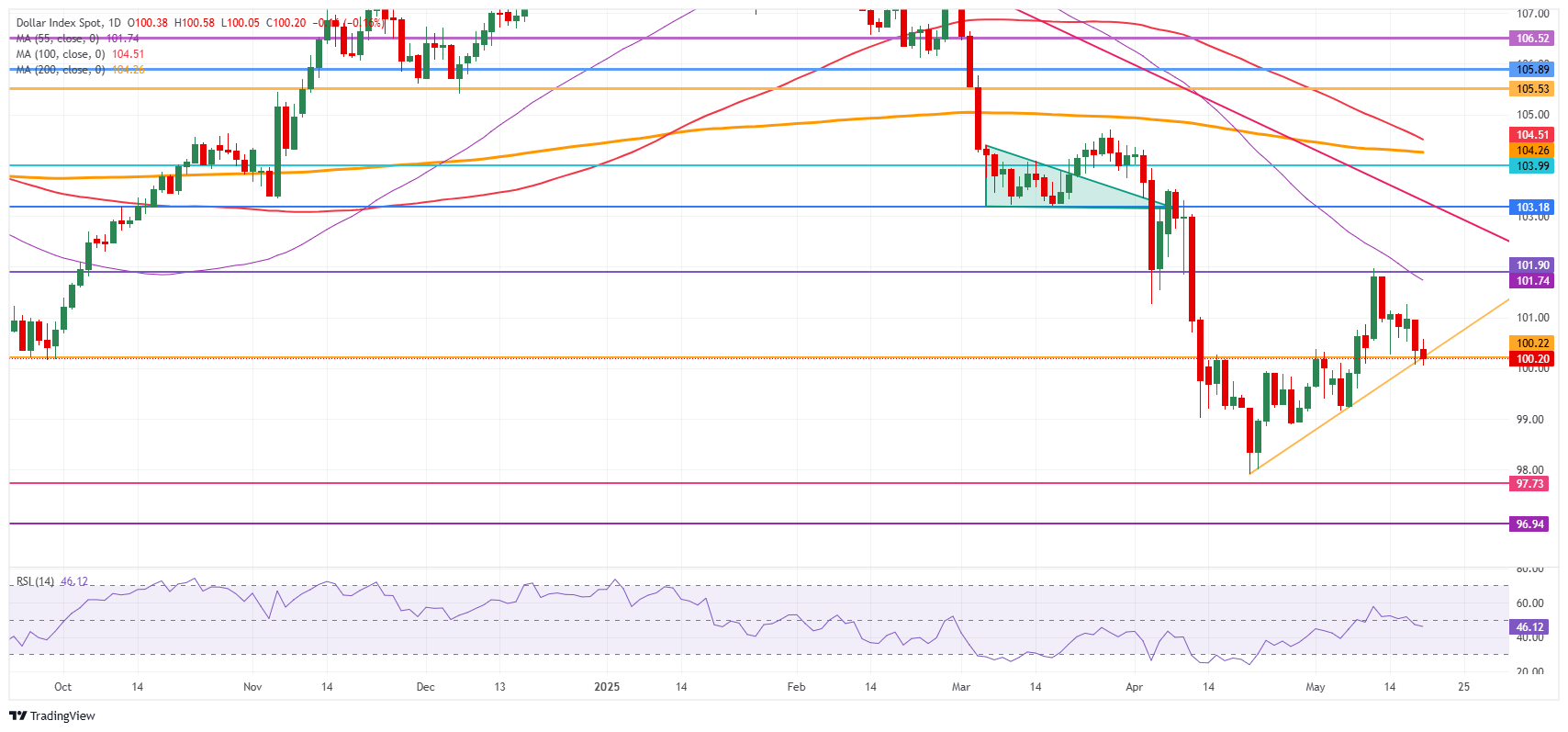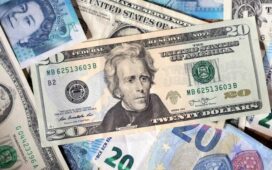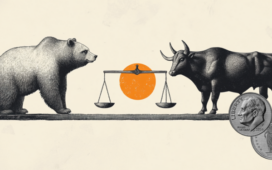- The US Dollar Index dips again to possibly test the 100.00 marker.
- Traders are on the lookout for possible more wait-and-see stance from upcoming Fed members.
- The US Dollar Index stable for now, though a revisiting of 2022 lows could become possible.
The US Dollar Index (DXY), which tracks the performance of the US Dollar (USD) against six major currencies, is trading lower again after investors share their concerns with the reservations Moody’s made during its US credit downgrade. A Deutsche Bank poll found 80% of investors agree the U.S. is on an unsustainable debt path, echoing Moody’s recent statements. Over half expect a future crisis will push lawmakers to cut the deficit, while 26% see quantitative easing as the likely solution. Only 20% believe markets will tolerate a 9% deficit or doubt it will reach that level by 2035,Marketwatch reports.
Outside the US, geopolitical tensions are picking up again. France, the United Kingdom and Canada are considering sanctions on Israel if the country does not call off its ground offensive in Gaza and allows food supplies to enter the Strip. Israel’s Prime Minister Benjamin Netanyahu pushed back by saying that Israel has the right to defend itself.
Regarding the Russia-Ukraine war, EU leaders condemned the retreat of United States (US) President Donald Trump after his two-hour call with Russian President Vladimir Putin. Despite the bold claims that a deal would be brokered within days after becoming President and that a peace deal would not be possible without the US, President Trump said that the US would back out of any further talks by saying “it’s not our war to deal with”, Bloomberg reported. The unraveling adds to further losing credibility, hitting the value of the US Dollar.
In a relatively calm week in terms of economic data, traders brace for more comments from Federal Reserve (Fed) officials on Tuesday after Monday’s mostly hawkish tone seen among many of them.
Daily digest market movers: Sticky concerns
- Markets are downgrading the US Dollar even further as US President Trump is apparently unfit to solve the Ukraine-Russia debacle. After the two-hour call with Russian President Putin, President Trump said talks between the EU, Russia and Ukraine would start, without any military or sanction-related support in order to speed up the peace process, Bloomberg reports.
- An army of Fed speakers stands ready on an otherwise dry Tuesday in terms of US economic data:
-
- At 13:00 GMT, Federal Reserve Bank of Richmond President Thomas Barkin speaks on growth in rural communities at the Investing in Rural America Conference in Roanoke, Virginia. No comments were made on the Fed’s policy.
- At 17:00 GMT, St. Louis Fed President Alberto Musalem speaks at the Economic Club of Minnesota Event at the University of Minnesota Campus.
- Near 21:00 GMT, Federal Reserve Bank Governor Adriana Kugler delivers a commencement address at the Spring 2025 Berkeley Economics Commencement Ceremony..
- At 23:00 GMT, Federal Reserve Bank of Atlanta Raphael Bostic speaks on a panel with other Reserve Bank presidents at the Atlanta Fed’s 2025 Financial Markets Conference in Florida.
- At that same time, Federal Reserve Bank of San Francisco President Mary C. Daly and Federal Reserve Bank of Cleveland President Beth M. Hammack both participate in a moderated Q&A.
- Equities are mixed on Tuesday, with European equities edging up after the German DAX eked out another all-time high. US equity are struggling, down 0.50% on the day after the US Opening Bell.
- The CME FedWatch tool shows the chance of an interest rate cut by the Federal Reserve in June’s meeting at just 8.6%. Further ahead, the July 30 decision sees odds for rates being lower than current levels at 33.1%.
- The US 10-year yields trade around 4.49%, surging back while US bond prices are dropping.
US Dollar Index Technical Analysis: Small bounce infused
The US Dollar Index is losing some more of its shine on Tuesday. After the creditworthiness and its safe-haven status issue due to the credit rating downgrade, the fact that President Trump might walk away from any further attempts to end the war between Russia and Ukraine can be perceived as another element of untrustworthiness. The fact that the Trump administration might switch or even U-turn on any matter will stick with trader sentiment when considering how to deal with the US Dollar.
On the upside, 101.90 is the first big resistance again as it already acted as a pivotal level throughout December 2023 and as a base for the inverted head-and-shoulders (H&S) formation during the summer of 2024. The 55-day Simple Moving Average (SMA) at 101.94 reinforces this area as strong resistance. In case Dollar bulls push the DXY even higher, the 103.18 pivotal level comes into play.
As for supports, the ascending trend line and support level at 100.22 is under pressure and could snap at any moment if more selling pressure emerges. A nosedive move could materialize towards the year-to-date low of 97.91 and the pivotal level of 97.73. Further below, a relatively thin technical support comes in at 96.94 before looking at the lower levels of this new price range. These would be at 95.25 and 94.56, meaning fresh lows not seen since 2022.

US Dollar Index: Daily Chart
GDP FAQs
A country’s Gross Domestic Product (GDP) measures the rate of growth of its economy over a given period of time, usually a quarter. The most reliable figures are those that compare GDP to the previous quarter e.g Q2 of 2023 vs Q1 of 2023, or to the same period in the previous year, e.g Q2 of 2023 vs Q2 of 2022.
Annualized quarterly GDP figures extrapolate the growth rate of the quarter as if it were constant for the rest of the year. These can be misleading, however, if temporary shocks impact growth in one quarter but are unlikely to last all year – such as happened in the first quarter of 2020 at the outbreak of the covid pandemic, when growth plummeted.
A higher GDP result is generally positive for a nation’s currency as it reflects a growing economy, which is more likely to produce goods and services that can be exported, as well as attracting higher foreign investment. By the same token, when GDP falls it is usually negative for the currency.
When an economy grows people tend to spend more, which leads to inflation. The country’s central bank then has to put up interest rates to combat the inflation with the side effect of attracting more capital inflows from global investors, thus helping the local currency appreciate.
When an economy grows and GDP is rising, people tend to spend more which leads to inflation. The country’s central bank then has to put up interest rates to combat the inflation. Higher interest rates are negative for Gold because they increase the opportunity-cost of holding Gold versus placing the money in a cash deposit account. Therefore, a higher GDP growth rate is usually a bearish factor for Gold price.





